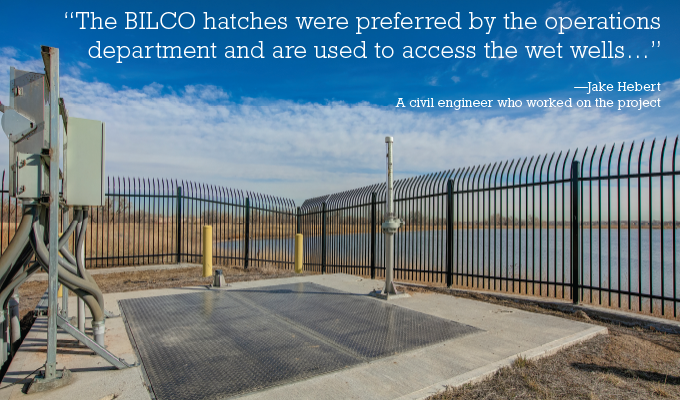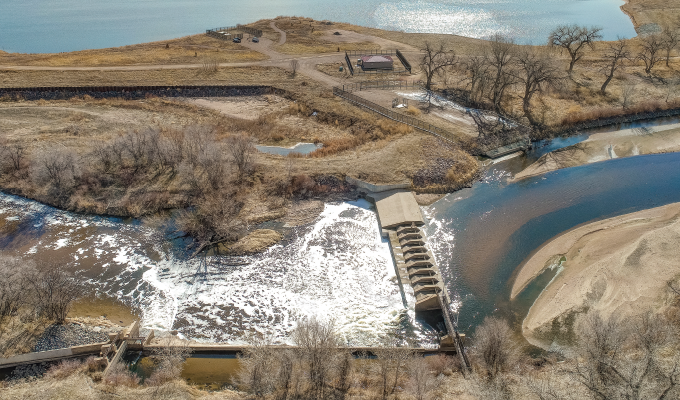By Thomas Renner
Water is a treasured resource in the community of Brighton, Colorado. With an average annual rainfall of only 15 inches per year, and a population growth of more than 19 percent since 2010, government officials searched for a solution to meet current and future water needs in the fast-growing town just twenty-three miles east of Denver.
The solution, the Erger’s Pond Augmentation Station, is a $5.4 million project that was completed last year. Aslan Construction built two raw water pump stations near a city-owned reservoir that is used for water storage. The reservoir is located adjacent to the South Platte River. One pump station is used to fill the reservoir by pumping river water into the reservoir. The other reservoir is used to pump water back into the river.
The pumps work at cross purposes, but that is to ensure that other communities along the South Platte River—which is the main water resource for Eastern Colorado—have an ample supply of water. Water augmentation plans were established in Colorado in the 1969 Water Rights Determination and Administration Act. One part of the plan requires junior water users on over-appropriated streams to obtain sufficient replacement water to offset depletions to senior water rights. Colorado is one of only a handful of states to adopt augmentation legislation.
“Water in the West,” says Dawn Hessheimer, water resource specialist for the City of Brighton, “is very different from water rights in the Eastern United States.”
PROJECT GLANCE
The project developed out of the city’s need to expand its ability to meet augmentation requirements. “Historically, Brighton had been using temporary pumps that were costly and inefficient,” says Jake Hebert, a civil engineer who worked on the project. “Construction of permanent infrastructure to facilitate pumping operations was necessary and beneficial to the city.”
Teams installed nine submersible pumps in underground wet wells to move the water, along with a gravity line. The improvements also included new spillways to direct water flow and “riprap” slope protections to protect the pond’s banks from erosion.
“Improving the slopes and spillways are vital to keeping the pond from being washed out,” says Curt Bauers, then the city’s utilities director. “There was a town that lost one of its reservoirs back in 2015 because of an unprotected spillway. The river poured in, undercut an embankment until it didn’t exist anymore, and all the water in the pond went down the river.”
The primary purpose of the reservoir is to capture and store water during times of high flows and free river. “During times when the river is typically lower and the city has augmentation requirements, water can be pumped back into the river to maintain healthy river flows,” Brighton officials wrote in a description for the American Public Works Association. The Colorado APWA awarded the city an award for the project in 2019.
SOLVING CHALLENGES
Hebert said a key challenge was placing the reservoir filling pump and wet well on a narrow strip of land between the river and the reservoir. “This was the most optimal place to have it. However, due to the reservoir slurry wall, it posed challenges to design and construct the wet well where the slurry wall is located and still maintain function of the slurry wall,” Hebert adds.
Some of the slurry wall—a clay bentonite wall usually built around reservoirs to prevent water leakage in and out of the reservoir—had to be removed to build the wet well and pump station. “Much care was taken to rebuild the slurry wall, and it resulted in no leaks,” Hebert says.
The wet wells are accessed by fourteen floor doors manufactured by The BILCO Company. The doors are manufactured from aluminum and feature type 316 hardware for corrosion resistance and many years of dependable service. They feature engineered lift assistance for easy, one hand operation, automatic hold open arms, and an industry-leading twenty-five-year warranty. Tim Bosworth of Dalco Industries procured the doors for Aslan Construction.
“The BILCO hatches were preferred by the operations department and are used to access the wet wells,” Hebert says. “They were installed directly above all of the submersible pumps to provide a way to pull the pumps from the wet wells for maintenance and future replacement.”

UNDERSTANDING AUGMENTATION
Water allocation is one Colorado’s, and Brighton’s, most pressing issues and has been so for centuries. Zebulon Pike, one of America’s earliest western explorers, referred to Brighton in his diary as the “Great American Desert.” The Colorado Encyclopedia states that before Colorado achieved statehood in 1876, “water scarcity drove the territory to adopt the Colorado doctrine,” a water allocation system whose basic premise was “first in time, first in right.” Just a decade after statehood, “the Platte was already over-appropriated,” according to the Encyclopedia article.
Colorado’s water crisis is exacerbated by its unique topography. The state’s Western Slope, defined as being west of the Continental Divide, receives about 80 percent of the state’s water supply. About 80 percent of the state’s population, however, resides on the much drier eastern side of the divide.
Augmentation is a relatively new concept that has allowed people to manage allocation. “The concept came around as an opportunity to augment supplies so that they are not adversely impacting senior water right holders,” says Scott Williams, education and outreach coordinator for Water Education Colorado. “Augmentation plans have been developed so that folks using wells can mitigate that impact on senior water rights holders.”
Under Colorado law, court-decreed rights, or “senior rights,” have priority to divert water in times of short supply before later-acquired rights, or “junior rights.” The policy dates back to the “first in time, first in right” law from the late 1800s.
Brighton’s primary water supply comes from alluvial groundwater wells, Hessheimer says, which have junior water rights. Therefore, the town must augment water so as not to impact senior water rights downstream.
“Brighton water storage reservoirs are a vital component to our municipal water system and our ability to supply water to our citizens,” Hessheimer adds. “Think of the chicken and the egg. Which came first? You cannot legally draw water from wells for treatment without the ability to augment the well pumping.”
STRAINED SERVICES
Brighton’s population has grown significantly since 2000. The population rose by more than 56 percent from 2000 to 2010, to more than 33,000 residents. It is expected to surpass 41,000 in 2020, nearly double its population in 2000.
The growth has strained community resources. Several schools are over capacity, and more are needed. The school district expects a nearly 40 percent increase in student enrollment by 2028. The surge in population has also affected its water supply. Due to the creative solution identified by city leaders, Brighton can be sure its residents will have enough water for its residents and meet its augmentation requirements. The augmentation station helps solve a water challenge that had been encountered by its earliest settlers.
“By completing the project as designed, the city has achieved the set goal because Erger’s Pond is now equipped with permanent pump station infrastructure to transfer water between it and the South Platte River,” the city wrote in its submission to the APWA.
FOR MORE INFORMATION
Thomas Renner writes on building, construction and other trade industry topics for publications throughout the United States.
MODERN PUMPING TODAY, September 2020
Did you enjoy this article?
Subscribe to the FREE Digital Edition of Modern Pumping Today Magazine!



